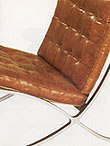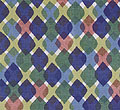|
|||||||||
|
Masterpieces from the Vitra
Design Museum The Opulent Eye of Alexander Girard
During a recent exhibition, the Cooper-Hewitt
was host to some of the world's most famous chairs. The title of
the show, "Masterpieces of the Vitra Design Museum," was
strangely inclusive considering 99.9% of the pieces in the show
were chairs. This was a veritable visual encyclopedia of chair design,
featuring selections from designers such as Charles Eames, Eero
Saarinen, Karl Schinkel, and Phillipe Starck. If one had never seen
an original Eames Lounge Chair (1956) or Nelson Marshmallow couch
(1956), this was the place to tic those boxes. Although it certainly
was nice to see the real thing, the ubiquity of these pieces (the
former can be seen in Frasier Cranes' apartment and the latter in
Austin Powers' bachelor pad in The Spy who Shagged Me) made the
trip to the Cooper-Hewitt seem almost unnecessary. In fact, if one
learned nothing else from the show, it was about the enduring popularity
of many of the pieces exhibited. By displaying chairs almost exclusively, the Cooper-Hewitt nicely maintained a focus on the design of the chairs. This also highlighted their considerable aesthetic qualities. For what better way to examine the principals of and approaches to design than by assembling a myriad of pieces that perform the same essential function and exhibit a myriad of design approaches? After looking at chair after chair, this reviewer could not help considering the utility of each piece in addition to its aesthetic appeal or lack thereof. The large, red UP 5 designed by Gaetano Pesce (1969), for example, seemed almost perverse in its overbearing, voluptuous form. Its label stated that the chair and its ottoman were meant to evoke a female form and specifically the female as the "ball and chain." Indeed, with its red nylon covering oozing from behind the upholstery buttons and attached by a string to a ball-shaped ottoman, the puffy foam chair did suggest as much. This being the third room of chairs, however, when seen from across the room, one's first thought was "gosh that looks comfy." This reaction is in contrast to that experienced upon entering the exhibit; then, one admired the sleek design of Rietveld's Roodblauwe Stool (1918) rather than wincing at the though of trying to settle into such unyielding wooden boards. The chairs were not simply placed in the rooms willy-nilly, however. The curators organized the show along broad themes: manifesto, reduction, decoration, organic design technology. These groupings were announced as names stenciled on the wall of each room accompanied by a few lines of text. To be honest, they were hardly noticeable. Because the wall text provided less than rigorous categorizing (the chairs in the "manifesto" room might just have easily appeared in the "decoration" room), one simply appreciated each chair and considered its success or failure as a seating device. It might have been better if the chairs had been placed in the galleries to be absorbed and quantified at leisure. One was also given the opportunity to appreciate the unique relationship between chair design and technological advancement. Though the object of the chair itself is very basic, designers have turned to the latest in modern materials and machining to make their chairs. Karl Friedrich Schinkel's Garden Chair (1820-25) shows that technological concerns in furniture making has long been present. The Garden Chair's cast-iron construction represents the impact of the Industrial Revolution on furniture design and construction. In the 20th century, Charles and Ray Eames became known for their use of technology to produce sleek, modern chair designs that could be mass-produced and sold cheaply. Their 1950-53 fiberglass molded Plastic Side Chairs are but one example of their achievements.
In contrast to the sober considerations of the impact of technology on modes of seating, "The Opulent Eye of Alexander Girard" in the upstairs galleries of the museum provided a largely chair-less, brightly colored antidote. It was also better organized and more focused. This show provided the visitor with a comprehensive overview of Girard's work and, in doing so, provided insight into 1960s design aesthetic in general. Girard (1907-93) was raised in Italy and educated as an architect in Rome and London before moving to the United States in 1932. After World War II, he worked with the Eameses, Eero Saarinen and George Nelson, joining their quest to provide accessible modern design to the middle class. Ultimately, as explained in the show's brochure, Girard "defined a 'look' that became synonymous with the 1960s." The Cooper-Hewitt's exhibition was an attempt to capture this look and examine the man behind it. And, in a relatively small space, the museum was largely successful in encapsulating a particularly wide-ranging career. Like the Eameses, Girard seems to have tried his hand at just about everything from furniture design to matchbook covers. They seem to have subscribed to a conception of design as a set of universally applicable principals, rather than specific motifs, patterns and blueprints. To demonstrate the depth of Girard's work and interests this show was filled with an eclectic range of objects and media. These included examples of his own designs as well as selections from his folk art and matchbook collections. Clearly organized rooms and specific areas of the gallery were dedicated to individual projects on which Girard worked or with which he was involved. For example, one wall focused on Girard's work for Braniff airlines by displaying his mock-ups for salt and pepper packets along with photos of flight attendants jauntily posed in the colorful clothes Girard designed in collaboration with Pucci. Another room focused on Girard's textile design and featured examples of his designs hung in tapestry fashion on each wall of the room.
Perhaps most interesting was the room devoted to Girard's design for La Fonda del Sol, a Spanish restaurant that was located in the Time Life Building in New York City from 1961-1971. Although he collaborated with the Eames's office on this project (the Eames specially designed chairs for the restaurant), it reflects Girard's ability to create a design scheme and carry it through a wide range of objects of varied use and materials. Featured in the show are a scale model of the restaurant and numerous items he designed for it, from dishware to matchbooks (Fig 3). The restaurant was well received by the public and served to establish Girard's reputation in the design community. With its myriad of objects in rich colors and patterns, the Girard exhibit was, if nothing else, a great pleasure to look at. Juxtaposed with the more circumscribed scope of the Vitra Design show, the two were a satisfying, not unrelated pair. Once one had marveled at the amazing variety of chairs and their admirable use of high technology, one could go upstairs and marvel at the amazing variety of designs within the career of one man. Thus, in one afternoon could one be both educated and entertained. To see more images from these shows, visit the Past Exhibitions portion of the Cooper-Hewitt's web site: http://www.si.edu/ndm. Visit the Vitra Design Museum's web site at http://www.design-museum.de. |
|||||||||


